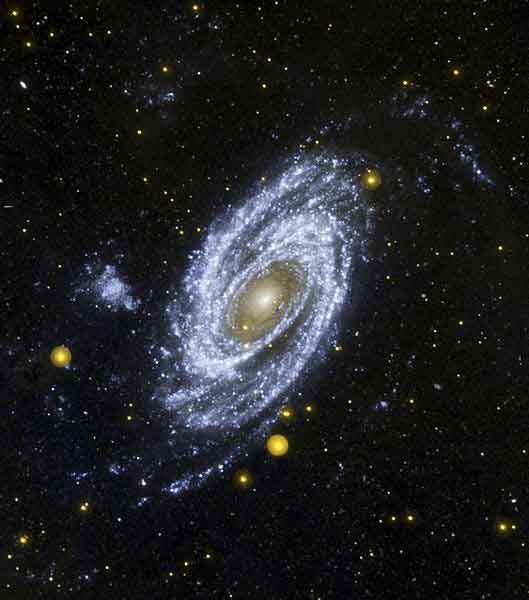
A GALEX image of the spiral galaxy Messier 81 in ultraviolet light. Credit:GALEX/NASA/JPL-Caltech.
Ultraviolet astronomy is generally used to refer to observations at ultraviolet wavelengths between approximately 100 and 3200 Å.[1] Light at these wavelengths is absorbed by the Earth's atmosphere, so observations at these wavelengths must be performed from the upper atmosphere or from space.[1]
Ultraviolet line spectrum measurements are used to discern the chemical composition, densities, and temperatures of the interstellar medium, and the temperature and composition of hot young stars. UV observations can also provide essential information about the evolution of galaxies.
The ultraviolet Universe looks quite different from the familiar stars and galaxies seen in visible light. Most stars are actually relatively cool objects emitting much of their electromagnetic radiation in the visible part of the spectrum. Ultraviolet radiation is the signature of hotter objects, typically in the early and late stages of their evolution. If we could see the sky in ultraviolet light, most stars would fade in prominence. We would see some very young massive stars and some very old stars and galaxies, growing hotter and producing higher-energy radiation near their birth or death. Clouds of gas and dust would block our vision in many directions along the Milky Way.
The Hubble Space Telescope and FUSE have been the most recent major space telescopes to view the near and far UV spectrum of the sky, though other UV instruments have flown on sounding rockets and the Space Shuttle.
Ultraviolet Space Telescopes
* Orbiting Astronomical Observatory
* International Ultraviolet Explorer
* Astron-1
* Hubble Space Telescope
* FUSE
* GALEX
* Swift Gamma-Ray Burst Mission
* Extreme ultraviolet Imaging Telescope
References
1. ^ a b A. N. Cox, editor (2000). Allen's Astrophysical Quantities. New York: Springer-Verlag. ISBN 0-387-98746-0.
Retrieved from "http://en.wikipedia.org/"
All text is available under the terms of the GNU Free Documentation License

